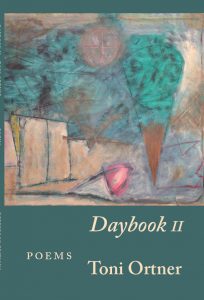poems
Toni Ortner
ISBN: 978-1-7343884-4-2
6 x 9; 70 pages; $18.00
About the author
Toni Ortner was an English teacher at the University of Connecticut, Monroe College, and at Bronx Community College, as well as at various high schools in New York state.
She has had 26 books published by small presses. Her most recent is Daybook II by Deerbrook Editions. She lives in Vermont where on the fourth Sunday of each month from 5- 6 PM, she hosts the Write Action Radio Hour on l07 7 FM and interviews writers and has them read their work. She is Vice President of Write Action which is a nonprofit group that supports writers in New England through a variety of events. Her recent work can be seen at vermontviews.org at Old Lady Blog along with reviews of her published books. She gives readings in bookstores and libraries in Vermont and New Hampshire.
Daybook I by Toni Ortner is also available on this site.
Visit her blog on vermontviews
Praise for Toni Ortner’s work
Toni Ortner’s Daybook II is charred in the rubble of memory, and the surreal runs through it. Like Anna Kavan’s Ice she gives us a disturbed interior landscape that haunts our visions for the future with lamentation and dissonant song.
—Terry Hauptman, author of On Hearing Thunder, The Indwelling of Dissonance, and the Tremulous Seasons.
Praise for Daybook I
The writing in Toni Ortner’s Daybook I is lyrical but rooted in present tense, observations deeply felt.
It consists of spiritual musings, political musings, musings about life. The writing is unself-conscious, but finely hewn.
Many of the passages, though written in paragraph form, read as poetry. The poems can be satisfyingly evocative: The hot cup of coffee you brought to my bed/how you said the dead are always with us/if we listen to the voices in our heads/how in spite of the depth of the wound you never cried/the dark into which I fly/the light in your eyes.
At times it’s difficult to tell if a scenario is imagined or “real” which for me enhanced my engagement and enjoyment. After all, the imagined can seem to the imaginer more real than “reality;” dreams can take on a life of their own and impact our relationship with the embodied world. Ortner seems to find expansion, reflection in the dream world. It adds a rich texture to the passages here.
There can be deadpan humor when imagination mixes with the banal as in recollecting the figure of Death from a dream: He stood there with a raincoat slung over his shoulder. He was chewing gum. It smelled like Dentine.
That it is all together in Daybook I—dream, thought, memory, event,creates a fluid landscape that captures well the interstices between a rich inner life and its sometimes difficult-to-navigate outer manifestations.
—Arlene Distler
